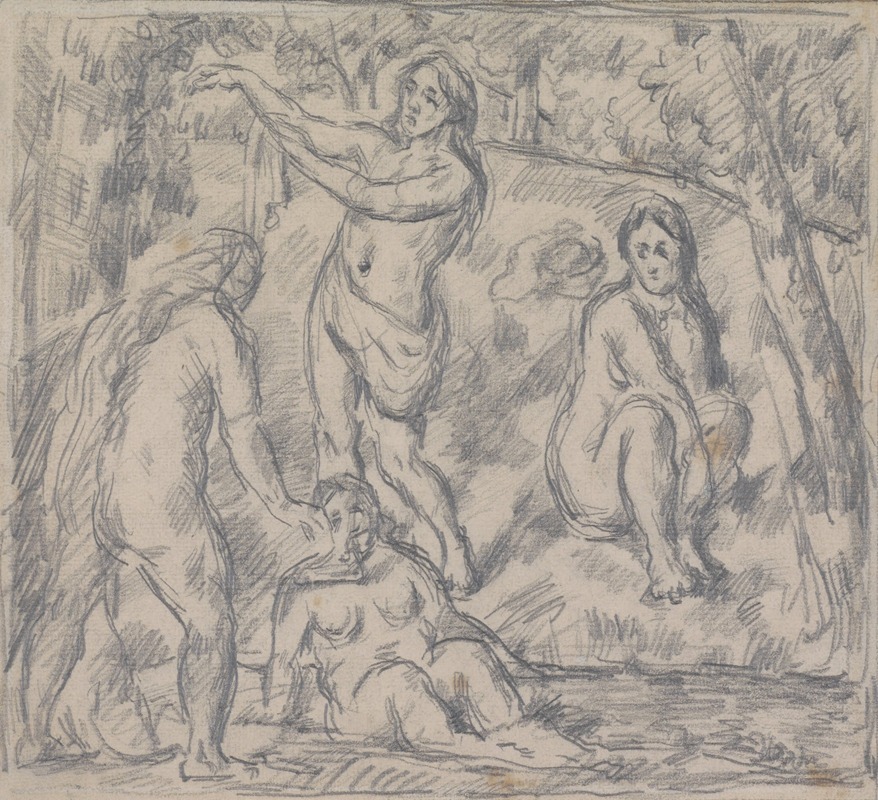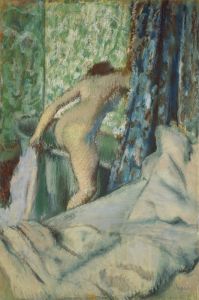
Study of Four Women Bathing
A hand-painted replica of Paul Cézanne’s masterpiece Study of Four Women Bathing, meticulously crafted by professional artists to capture the true essence of the original. Each piece is created with museum-quality canvas and rare mineral pigments, carefully painted by experienced artists with delicate brushstrokes and rich, layered colors to perfectly recreate the texture of the original artwork. Unlike machine-printed reproductions, this hand-painted version brings the painting to life, infused with the artist’s emotions and skill in every stroke. Whether for personal collection or home decoration, it instantly elevates the artistic atmosphere of any space.
Paul Cézanne's "Study of Four Women Bathing" is an intriguing work that reflects the artist's evolving style and his exploration of form and composition. Cézanne, a pivotal figure in the transition from 19th-century Impressionism to 20th-century Cubism, is renowned for his unique approach to painting, which often involved a meticulous study of his subjects and a focus on the underlying structure of forms.
This particular study is part of Cézanne's broader series of works focused on the theme of bathers, a subject he revisited numerous times throughout his career. The theme of bathers allowed Cézanne to explore the human form in a natural setting, emphasizing the relationship between figures and their environment. His interest in this subject can be traced back to his admiration for classical art and his desire to capture the timeless quality of the human body.
In "Study of Four Women Bathing," Cézanne employs his characteristic brushwork and use of color to create a sense of depth and volume. The figures are depicted with a sense of solidity and weight, yet they are also integrated into the landscape in a way that blurs the boundaries between the figures and their surroundings. This integration is achieved through Cézanne's use of color modulation and his attention to the interplay of light and shadow.
The composition of the painting is carefully constructed, with the four women arranged in a way that guides the viewer's eye across the canvas. Cézanne's use of geometric shapes and his focus on the underlying structure of the forms are evident in the way the figures are positioned and how they relate to one another. This structural approach is a hallmark of Cézanne's work and would later influence the development of Cubism and modern art.
Cézanne's bathers are not idealized figures; instead, they possess a raw, almost sculptural quality that reflects the artist's interest in capturing the essence of his subjects. The figures in "Study of Four Women Bathing" are rendered with a sense of immediacy and presence, yet they also convey a sense of timelessness, as if they are part of the natural world rather than separate from it.
This study is a testament to Cézanne's dedication to his craft and his relentless pursuit of capturing the truth of his subjects. His innovative approach to form and composition challenged the conventions of his time and laid the groundwork for future generations of artists. Cézanne's influence can be seen in the works of artists such as Pablo Picasso and Henri Matisse, who admired his ability to convey the complexity of the natural world through his art.
"Study of Four Women Bathing" exemplifies Cézanne's mastery of color, form, and composition. It is a work that invites viewers to contemplate the relationship between the human figure and the natural environment, and it continues to be celebrated for its contribution to the evolution of modern art. Through this study, Cézanne not only captured the beauty of the human form but also redefined the possibilities of painting, leaving a lasting legacy that continues to inspire artists today.


















